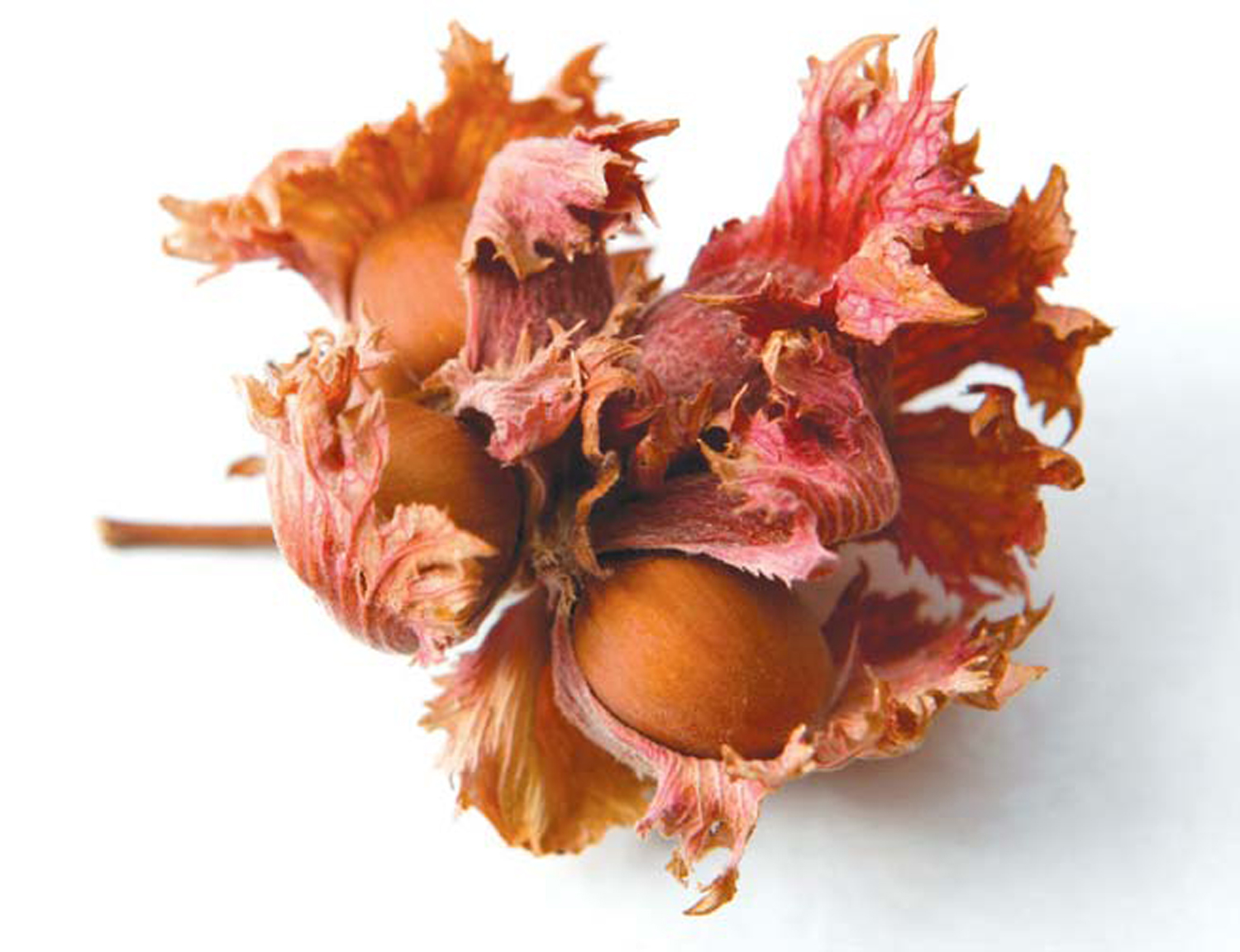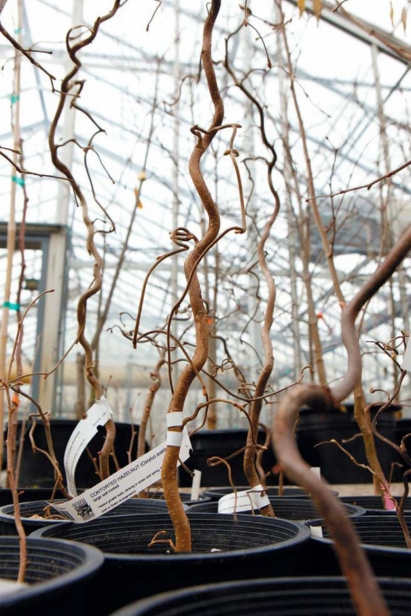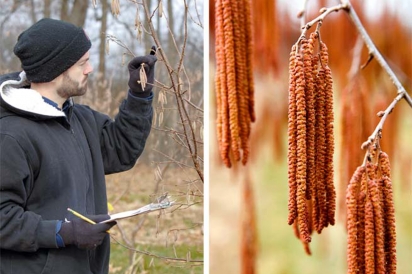A New Look at an Old Nut
Location can be an economic blessing or a curse. Or, as New Jersey’s farmers know, it can be a bittersweet combination of both.
Squeezed between two major cities, farming in New Jersey means ready access to millions of home cooks and chefs. At the same time, development pressure swallows up farms—driving up the cost of purchasing and managing the farmland that remains. To survive, New Jersey’s farmers try to get the most out of their land by raising high-demand, high-value crops.
Thanks to a hazelnut-breeding program at Rutgers, our farmers may soon have a new low-input, high-value crop to further strengthen their bottom lines. This crop has the added advantage of being suitable for growing on currently unused land.
In 1996, C. Reed Funk, a preeminent Rutgers plant breeder, handed his successful turfgrass breeding program over to a younger colleague and turned his attention and talents to food—specifically, to improving underutilized perennial crops. His explorations were inspired by the ideas of J. Russell Smith, a Columbia professor and author of Tree Crops: A Permanent Agriculture. As early as 1929, Smith argued for the replacement of annual crops on hilly land with improved tree crops that provide nutritious food.
Together with one of his students, Thomas Molnar, Funk brought many types of nut-producing trees to Rutgers—including walnuts, chestnuts, almonds, hazelnuts and pistachios—to test their viability as farm crops. His goal was to develop a breeding program focused around the two or three nut species that did best here. From that program would come new cultivars and, with them, a new industry. Hazelnuts stood out as having great potential. Molnar, now assistant professor of plant biology at Rutgers and a plant breeder at the Rutgers New Jersey Agricultural Experiment Station, focused his research on developing hazelnut trees that can thrive in New Jersey.
The American hazelnut, native to much of the eastern United States, produces nuts that are small and protected by a thick shell. This makes them unsuitable for commercial production. Hazelnut production in this country, which is limited to a small area in the Pacific Northwest, is based on a few European cultivars that have been selected to produce meaty nuts with thin shells. But unlike our native hazelnuts, European cultivars are susceptible to eastern filbert blight, a fungal disease that can kill hazelnut trees within a few years of planting. The goal of the Rutgers breeding program is to develop hazelnut trees that are resistant to blight and consistently produce a high volume of high-quality nuts.
“Through breeding, I can take this Italian tree, which has excellent nuts, cross it, grow out the offspring and find one that’s got good nuts and is resistant,” explains Molnar. “That’s what we have been doing here for the past 12 years or so—crossing the good ones with the resistant ones and looking for a combination of the two.”
The first step in the breeding program was to gather a broad array of diverse genetic material from cultivated and wild hazelnuts in hopes of finding those rare plants that are blight resistant. Funk and Molnar planted European cultivars, American-European hybrids and hybrids of Turkish tree hazels. And they planted hazelnuts, which are the seeds of the hazelnut tree. For ten years running, Funk sent Molnar on nut-collecting trips that included areas of Russia, the Ukraine, Belarus, Moldova and the Baltic countries. There Molnar collected nuts from the wild and from other research institutions. He also purchased hazelnuts from roadside stands, bazaars and small markets.
Collecting nuts is the easiest way to capture a wide spectrum of genetics. The nuts Molnar purchased in those markets and bazaars were often harvested from backyard trees. Such trees likely developed over generations from localized selection—offering the Rutgers team genetic material that differed from the common commercial cultivars. And, because hazelnuts are wind pollinated, the pollen that fertilizes fl owers even on cultivated trees can come from anywhere—including the wild hazelnuts that still thrive on the hillsides in these regions. This mixing of wild and domesticated trees increases the genetic diversity in the resulting nuts.
Thousands of hazelnut trees have been planted at Rutgers and intentionally exposed to blight, their ranks then thinned to include only those that survive the exposure. Years of crossing the surviving trees has yielded many sources of resistance, so that blight is no longer the biggest obstacle to developing hazelnuts for New Jersey. Molnar’s focus now is on improving the yield and quality of nuts. “The betterquality nut I can develop for our trees, the better price future farmers will get for them,” he says.
To guide his assessment of hazelnuts in the lab, Molnar uses quality standards from Ferrero, the world’s largest purchaser of hazelnuts and maker of Nutella and Ferrero Rocher chocolates. Companies like Ferrero pay a premium for quality, especially if it approaches the quality of the Tonda Gentile delle Langhe—a premium hazelnut grown in northern Italy that is prized for its superior fl avor, bright white color and roundness, and the ease with which the nuts shed their skin after roasting.
Given a growing demand for hazelnuts and a shortage of highquality hazelnuts in the world market, Molnar believes that our farmers will benefi t greatly if New Jersey becomes a center of hazelnut production. Still, he is cautious about moving too quickly to get his experimental varieties onto farms. Hazelnut orchards can be productive for 60 years, so it is crucial to have trees that will perform well over time. Molnar predicts that within fi ve years he will be ready with plants, but even then, he wants farmers to start slowly by planting only one or two acres.
Once the quality and yield are established, Molnar knows that hazelnuts will appeal to New Jersey’s sustainably focused farms (see sidebar). Compared to most annual crops, their water needs are small and they require little in the way of inputs such as fertilizers. Hazelnuts grow well on slopes not suitable for cultivation, providing income from previously unused or misused land. As a perennial, hazelnuts don’t require annual plowing, and they don’t need particularly rich soil. They develop an extensive root system that can stabilize soil to prevent erosion, capture rainwater to recharge groundwater and prevent fl ooding, and sequester carbon, which may help to slow climate change. And they create windbreaks and habitat for wildlife.
New Jersey’s small size and dense population require that we make good use of our land, both economically and ecologically. To that end, Molnar shares J. Russell Smith’s vision of benefi ting humanity and the environment by integrating more nut crops into our farms and landscapes. “What really inspired me when I fi rst started working with Dr. Funk,” says Molnar, “was the idea that, when you look across a suburban landscape, you see all of these trees that could be nutproducing trees, like improved hickories or pecans, that have good nuts, provide shade, and have other ecological properties.” The widespread planting of improved hazelnuts will be a signifi cant—and tasty—step toward realizing that dream.
HAZELNUTS AS A SUSTAINABLE CROP
Double Brook Farm in Hopewell is already exploring the multiple roles hazelnuts can play on a diversifi ed farm. Chris Turse, Double Brook’s horticulturalist, planted two acres of hazelnuts interspersed with white oaks—both purchased from a nursery that inoculated their roots with truffl e spores. Along with providing hazelnuts for the farm’s bakery and restaurant, those two acres now have the potential to produce two other highly desirable products—truffl es (provided those spores can outcompete the native fungi) and hazelnut-fi nished pork.
Jon McConaughy, Double Brook’s owner, plans to feed hazelnuts and acorns to their Ossabaw Island pigs during their fi nal weeks of life. Ossabaws are the direct descendants of pigs brought to the New World by early Spanish explorers. This gives McConaughy hope that the nuts will impart a fl avor to the pork that is reminiscent of the highly prized acorn-fi nished Ibérico pork of Spain.
Turse, a Rutgers graduate and former student of Molnar’s, plans to plant more hazelnut acreage and is eager to get some experimental Rutgers varieties onto the farm. For him, because hazelnuts provide ecological services while producing both food and feed, they make an ideal addition to a sustainably managed farm.








